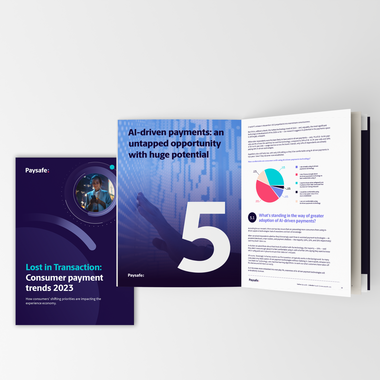
- Seven minutes read
Embedded finance applications and opportunities: right product, right time, right place
We’re seeing both tried-and-tested and more novel applications of embedded finance from players in all industries. Here we take a look at some use cases – and highlight the three critical elements that successful approaches have in common.
Bridging a gap
In exploring use cases across different sectors, we see common themes emerging. What’s central to them all is that they create a more fluid experience. But, more than that, they get one step closer to their customers, reinforcing brand trust and the subsequent loyalty this generates.
How close depends on market-specific factors. Regulation hoops. How high or low risk the sector is. The levels of security – not just the layers that are necessary, but those that make consumers feel comfortable (as we’ll see, sometimes friction can be a good thing).
Fly, fly away?
Opportunities tend to arise from not-so-ideal situations. A recent example of this that will resonate with many, was the considerable friction caused by the lockdown rules at various stages of the pandemic, which required would-be travellers to cancel flights and accommodation bookings. Hundreds of thousands of people in the UK alone having to claw back their money from airlines, hotels, car hire companies, and the rest. In the clamour, I expect more people than not had pretty poor experiences trying to get the various travel-related agencies to settle up.
But the frustration wasn’t just felt consumer side. Airlines, online booking agencies, and other travel merchants were plunged into an administrative nightmare. For a major airline, for instance, something like an airline voucher system is a huge operation involving departments of people and necessitating the shifting of money and vouchers from one place to another. Such a complex and time-consuming undertaking costing into the millions if not billions could have been entirely avoided with a simple embedded finance solution: an escrow account, by which a third party holds the funds until the service is delivered. In this case, when the traveller takes the flight. Indeed, a whole new type of service offering has emerged from this, with companies like Fly Now Pay Later taking a single use case and making a brand out of it.
Keeping them in your world
Some of the time, it’s not necessarily about solving a pressing or particularly acute problem. It’s about achieving seamlessness, making your customer happier – and keeping them in your ecosystem for a greater part of their journey.
The iGaming sector is a good example of this. A service based on immersive experiences, it’s obvious that anything that can make it more so is better for players. So in the case of the onboarding process, embedding a financial product can make this slicker by minimising the administration required to sign up new players. The player submits their details once and simultaneously registers with the iGaming merchant to get access to its services, as well as fulfilling the requirements for signing up to the digital wallet or other payment method that’ll then be linked to their account.
Crucially, this also means one set of Know Your Customer (KYC) processes and less chance of fraud. After all, the merchant already knows – and has a significant amount of transactional data on – the customer, so the relationship is established. On top of that, the insight that the merchant has through that customer data can then be used to anticipate their needs further down the line.
The crypto factor
No review of the drivers of embedded finance and changes in consumer appetite for alternative payment methods is complete without a look at cryptocurrency. Crypto has been an area of huge growth in the last couple of years, driven largely by consumer demand. According to Paysafe research – which surveyed 1,100 businesses across the UK, North America, Italy, Bulgaria, Germany, Austria, and Brazil, – nearly one in ten consumers have started using crypto as a payment method since the pandemic. While 17% of businesses say they already allow consumers to pay via crypto in some form, and a further 36% plan to introduce crypto into their checkout the next 12 months.
The call for crypto at checkout is going to be higher in some markets – for example, gaming and tech-related products and services – than others. But we’re currently seeing an increase across the board, so building it into the checkout experience is no longer a lookout for niche merchants and services providers. However, it’s a more complicated process than, say, adding a digital wallet. You need to understand the anti-money laundering, KYC, and regulation issues around crypto. Here, a specialised embedded payments provider can help, giving insight into these needs – outlining what your responsibilities are and providing a range of alternative payment methods. Acceptance rates when buying crypto are typically higher when they are made through digital wallets as many banks reject them, which is also why it’s important to have choice and choose an embedded payments partner that has a good relationship with crypto-friendly banks.
Right-sizing security
This also highlights an important point about the role of security and embedded finance. We’ve touched on the differences of operating in markets with varying risk factors. And while we’re always saying that customers want less friction, sometimes it pays to have some well-placed friction to reassure them that their data and funds are being protected. Which means applying appropriate layers of security relative to what consumers are buying or doing in that ecosystem. If they’re trading in Ethereum, they might be pleased to go through two-factor authentication, type in the name of their first pet, school, and girlfriend’s name, and recite a pass phrase backwards. If they’re just booking an Uber, maybe they’d prefer to bypass some of those security steps.
Essentially, it’s about getting the right balance of security and usability.
#1 Enable integration. #2 Build trust. #3 Make it speedy
The three takeaways from our brief look at applications of embedded finance aren’t anything new. Broadly speaking, they have three things in common.
First, they provide integrated experiences. This is as much about making things work seamlessly as it is about creating an environment that consumers don’t want to leave.
Second, they work transparently, and the services they offer are transparent. Plus, they communicate that transparency to their customers. This is what generates trust within their ecosystem.
Third, when it comes to transactions, they know that real-time is key. Fast transactions are a must. Mess around with this aspect of consumer interaction, and you’ve lost them.
So, success is simply getting all of these factors spot on.
Great CX pivots on payments
As ever, all roads lead back to the customer experience – and payments functionality very much sits at the heart of that. Regardless of sector, target market, or type of offering, it’s just about making it easier for customers to pay for services.
The nature of online consumer interactions continues to shift. The key for merchants is having the flexibility to adopt the services they need to deliver the best experience, with the least friction, and the most appropriate level of security. Killer idea, perfectly executed. With the right business model and embedded payment solutions, that’s more possible than ever.
So, does every company need to be a fintech company? Probably not. But they do have to be 100% customer- and solution-driven. And whether they build, buy, lease – partner or go it alone – getting payments right should be a priority.




